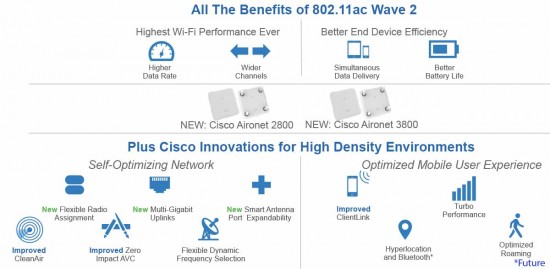
Recently, Cisco introduced new members to the 802.11ac AP family: the new Cisco Aironet 2800 and 3800 Series Access Points (APs).
Creating more bandwidth, the new Cisco 802.11ac Wave 2 APs are the high-performance products that enlarge your bandwidth and eliminate data gridlock.
Cisco Aironet 2800 and 3800 Series, as the world’s most versatile access points, meet 802.11ac Wave 2 standards and provide a theoretical connection rate of up to 2.6 Gbps per radio. That’s roughly double the rates offered by today’s high-end 802.11ac APs. And you’re going to need all the bandwidth you can get, as a recent study shows that within three years, the majority of fixed IP traffic will be Wi-Fi (53 percent), exceeding wired traffic by 21 percent.
The Aironet 2800 and 3800 Series APs are a great place to start and come equipped with the following innovations for a better, more robust bandwidth:
1. Flexible Radio Assignment: Every minute your environment changes; sometimes there may be 30 or more people in a conference room and other times it may be empty. The Aironet 2800 and 3800 Access Points will automatically recognize these discrepancies too. With two radios in the access point, when there is a greater need for bandwidth, the 2.4GHz radio will understand the situation and switch to a 5GHz radio. When that increased need subsides, the radio can either switch back to 2.4GHz or go into security monitoring mode and scan the perimeter for rogue agents.
2. Multiuser multiple-input, multiple-output (MU-MIMO) technology: When you have a large crowd of people all using their devices to connect to the same bandwidth, the Wi-Fi speed tends to slow down. That’s single-user (SU) MIMO at work. But with MU-MIMO supporting three spatial streams, you get significantly faster performance over more clients. Why? It’s simple, MU-MIMO allows the access point to send multiple data packets to multiple clients over the same frequency.
3. Mutligigabit Ethernet support: Providing multiple gigabit uplink speeds of 2.5 Gbps and 5 Gbps in addition to 100-Mbps and 1-Gbps speeds for NBASE-T over Cat6a and 10GBase-T cabling. This allows up to five times the speeds in enterprise without replacing cabling infrastructure.
4. High-Density Experience: Best-in-class RF architecture that provides high-performance coverage for a high density of client devices, giving the end user a seamless wireless experience. Features include custom hardware in 802.11ac Wave 2 radios, Cisco CleanAir®, Cisco ClientLink 4.0, cross-access point noise reduction, and an optimized client roaming experience.
5. 160-MHz Channel Support: Supporting channels up to 160 MHz wide, Dynamic Bandwidth Selection allows the access point to dynamically switch between 20-, 40-, 80-, and 160-MHz channels, depending on the RF channel conditions, providing the industry’s best-performing wireless network.
All of these functionalities, plus loads more, allow your access points—and your network—to run at peak performance.
These new products from Cisco allow you and your wireless network to be ready for the inevitable wave of 802.11ac Wave 2 consumer devices when they become available.
…
The original article written by Greg Dorai from https://blogs.cisco.com/wireless/expanding-your-network-creating-more-bandwidth
More Related…
Cisco Aironet 3800, the Newest Best-in-Class Access Point
Cisco IW 3700/IW3702 Access Point for Coolers
New Cisco Aironet 1830 Series APs-Gigabit Wi-Fi Has Fully Arrived
Available 802.11ac APs from Cisco, Aruba, HP and Ruckus Wireless
Cisco Aironet Series 3700 vs. AP 3600 Series






